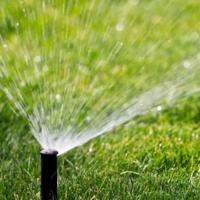Landscape Irrigation
by Guest Post on Jan 5, 2010
Most of the country is now under the influence of the hottest part of the year - even here in normally cooler north Idaho, temperatures have risen into the nineties for over a week. To keep your gardens thriving in these conditions is a challenge, and requires the careful management of irrigation practices.
The following tips will help set you up for a successful irrigation project:
Studies have indicated that plants utilize root zone water most efficiently during morning hours...try to irrigate very early in the day. Much of the water applied during the heat of the day is lost to evaporation - thirty percent or more is lost from overhead irrigation. Watering during the evening or nighttime hours may be acceptable, but plants that are susceptible to fungus diseases will suffer from being damp for an extended overnight period.
The general rule is to water as deeply and as infrequently as possible. Watering deeply and infrequently encourages the plant to develop a deep root system, which in turn increases drought hardiness since the soil dries from the top down. Frequent, light irrigation encourages a shallow root system that will suffer from every dry spell.
Many folks have asked how much, or how long to irrigate...this depends on the soil - and the crop. In an "average" loam, one inch of irrigation will penetrate twelve inches...in sandy soil, penetration will be deeper, and in clay soil, not as deep. For established shrubs in the average loam, thorough, deep irrigation once per week to the depth of one and one half to two feet should be adequate during the growing season. Since clay soils hold water longer, care must be taken to not overwater, which will exclude necessary oxygen from the soil profile.
(The "ideal" soil is composed of fifty percent solids, twenty-five percent liquid, and twenty-five percent air).
Plants have different water needs...for instance, the red-twig dogwood (Cornus stolonifera) will thrive in a soil that is always damp - but many other plants require a thorough drying between irrigations - so if at all possible, group plants of similar water needs together. The website review below refers to an excellent article about designing for efficient water use.
For lawns, there is no substitute for overhead irrigation. For shrub beds, vegetable and herb gardens, and fruit trees, drip irrigation is far superior - the plants receive a slow, metered supply of water, which is not as susceptible to losses from evaporation and overspray. For row crops in the vegetable garden, I've been using "porous pipe," made from recycled rubber, with great success.
As with most topics relating to the garden and landscape, irrigation solutions are dependent on site-specific conditions - you must know your soil and your plant needs to make the best irrigation decisions.
Popular Articles
Three Places to Spend Money on the Exterior of Your Home
When you have the exterior of your home remodeled, you are investing, time, energy and convenience into the project and you want to make sure that...
104833 Views
Homemade Headboards-Make an Upholstered or Wooden Headboard
Homemade headboards can add a lot of personality to any bedroom. They can be coordinated with existing furniture and room decor or they can be the...
80104 Views
When to Use a Brush, Roller or Sponge Brush
Brushes are a good choice for painting trim and woodwork. They are also useful for cutting in the edges around the top and bottom edges and corners...
72763 Views
Creating a Cottage Kitchen with Bead Board
Kitchen decor can range from modern and bold to elegant and elaborate by using strategic kitchen pieces. One of the most popular decorating trends...
58532 Views
Gas Fireplace Diagnostics and Troubleshooting
Follow these steps for diagnosing and troubleshooting Gas Fireplaces repairs. For the average DIYer, this may seem intimidating, depending on the...
35572 Views
Latest Articles
How Much Does it Cost to Take a Bath?
Plumbers know that a bath may seem like a relaxing luxury, but the real cost extends far beyond your water bill. The average soak uses 35 to 50...
on Apr 8, 2025
10 Concrete Patio Ideas on a Budget
A concrete patio can be a game-changer for your outdoor space. It is durable, versatile, and can be customized to fit your style. But what if you...
on Mar 25, 2025
Tips for Creating a Stunning Personalized Photo on Canvas
Order the unique beauty of a personalized photo on canvas and bring your memories to life. With a customized photo on canvas, you can transform...
on Mar 7, 2025
Best Areas to Buy Property in Singapore for Long-Term Growth
Singapore's real estate market remains one of the most stable and lucrative in the world. With limited land supply, strong governmental...
on Feb 18, 2025
Troubleshooting Excess Water in Your HVAC Secondary Condensate Drain Pan
When maintaining your air conditioning system, it is easy to overlook the condensate drain pan - until excess water starts pooling in places where...
on Jan 12, 2025
Featured Articles
What Type of Licensed Contractor Should You Hire?
on Feb 28, 2017
Hire Contractors / Estimates

Looking for a specialty project? There are many types of contractors available for your home improvement needs. Finding the right type of...
Sponsored Articles
Best Areas to Buy Property in Singapore for Long-Term Growth
on Feb 18, 2025
Real Estate / Finance

Singapore's real estate market remains one of the most stable and lucrative in the world. With limited land supply, strong governmental...
Actions
Top Categories
- Garden / Landscaping / Patio — 264
- Kitchen / Bathrooms — 240
- Real Estate / Finance — 203
- Appliance / Repair — 186
- Interior Design / Decor — 184
- HVAC / Air Conditioning — 148
- Cleaning / Maintenance — 144
- Improvements / Remodeling — 131
- Plumbing / Basements — 118
- Floors / Tile / Hardwood — 116
- Doors / Garages — 113
- Safety / Security — 113
Articles Archive
More DIY Articles
When Does My Roof Need to be Replaced?
Your home is probably the most valuable asset you own. In the interest of maintaining its value, it will need some maintenance over time. Included...
Advantages of Using Rubber for Your House Roof
If you are looking for a roofing material that will result in the least amount of maintenance and will offer you the protection you can count on,...
Landscape Designs for Backyards without Grass
Having a lawn in your backyard may be quite tedious and expensive. For maintenance, it will need large amounts of fertilizer, water, and even gas....
What Should I Consider Before Buying a Snow Blower?
You have come to the right place looking for tips when shopping for a new snowblower and the top 4 things to consider. Like with all purchases that...
How to Measure a New Garage Roller Door
Shed and garage roller doors are seen in nearly every home. Built to last with Colorbond steel or even wood, the garage door protects your home and...

